Vol 4 No. 20 TROPIC LIGHTNING NEWS May 19, 1969
Index
100 NVA Fall to Warriors' Might
CU CHI - The dark morning quiet was shattered by the eerie sound of
incoming mortars. The Warriors of the 2d Battalion, 12th Infantry, were in
a night laager ten miles north of Cu Chi in the Ho Bo Woods. The Fire
Brigade troops were about to face a determined assault of NVA.
"First came the mortars, 75 or more, followed by an RPG barrage,
then the ground assault," said First Lieutenant George Curtis of Brasher
Falls, N.Y. "Groups of attackers were spotted on three sides crowding
toward our concertina wire. They were moving up under the cover of
darkness and the mortar barrage."
"About 30 enemy were right in front of me," said Private First
Class Larry Goodson of Rose Lake, Idaho. "They were getting on line - so close
I could throw grenades. When I ran out of grenades, I got on the machine
gun and finished the job."
"Several enemy were found along the berm line," said Sergeant
Clinton Cooper of Mulligon, Mich. "This shows how close the fighting
was. Many were killed with hand grenades.
"They were going all out to overrun us," stated Specialist 4
Jim Conner of Rochester, N.Y. "We drove them back and forced them to
retreat completely. We just had too much firepower."
The Tropic Lightning troops were not alone in the defense.
Artillery, Cobra gunships, and Spooky blasted the enemy with massive firepower.
Spooky turned the night into day with flares.
The unknown sized enemy force lost 100 men in the two-hour fight,
as well as numerous weapons and ammunition.
"Some of the dead were wearing back packs for carrying RPG
rounds," said Goodson. "Each pack could hold six to eight rounds."
The dead had ropes around their necks, noted one Warrior officer.
The battalion Kit Carson Scouts told him that the ropes are used to drag the
dead away from the battlefield.
One hundred of the ropes were never used.
Also found in the area were 31 AK-47, 12 RPG launchers and the
usual battle flotsam of web gear and documents.
One prisoner and one of the dead were each found to have a copy of
last month's Playboy in their possession. The centerfolds, however, were
reported missing.
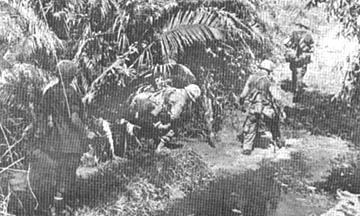 |
WET FEET AGAIN - Soggy socks are a certainty in this common situation, but at least these soldiers from the 2d Battalion, 27th Infantry, aren't likely to catch cold on this operation north of Cu Chi. (PHOTO BY SP4 R. B. WILLIAMS) |
Treasure Hunt Nets Weapons Gold Mine
DAU TIENG - Tropic Lightning mechanized infantrymen from the 3d
Brigade combined with Regional and Popular Forces units from Khiem Hanh District
recently and found a hidden treasure, 45 miles northwest of Saigon.
The booty - a gold mine of enemy weapons and munitions.
A combined force of mech infantry from Charlie Company, 2d
Battalion, 22d Infantry "Triple Deuce" and Vietnamese soldiers from the 872d
Regional Force (RF) Company and two Popular Force (PF) platoons were conducting
a sweep along a stream bed six miles southeast of Dau Tieng when they discovered
the X that marked the spot.
The Regional Force unit, commanded by Second Lieutenant Nguyen Ngoc
Thang and accompanied by Intergroup Commander, Captain Tran Van Phien, uncovered
two bunkers concealing more than 200 mortar and RPG rounds.
As cache discoveries mounted, Captain Alan Mayberry of
Bartlesville, Okla., senior American advisor of Advisory Team 90, called in the
Triple Deuce company to help in recovering the captured munitions.
Charlie Company, led by Executive Officer First Lieutenant James P.
Devereaux of Chicago, began sweeping toward the RF-PF positions.
"I had my men dismount after we received the call to help remove
the cache," recalled Devereaux. "As we swept toward the cache site, we
also began finding small caches in tunnels and bunkers, seven in all," he
said.
The Vietnamese and American troops continued scouring the area
until darkness made further efforts impossible.
When later counted, the cache discoveries totaled one 60mm mortar
tube, one 57mm recoilless rifle, one RPD light machine gun, nine SKS rifles, 120
recoilless rifle rounds, 274 mortar rounds, 207 RPG rounds, 116 hand grenades,
219 RPG boosters, two Claymores, two Bangalore torpedoes, 304 mortar fuses,
primers and charges, 2,000 rounds of ammunition and 89 pounds of TNT.
"This is by far the largest cache we have uncovered since I have
commanded the battalion," said Lieutenant Colonel Ralph Cline of Rockville,
Md., "Triple Deuce" commander. "A coordinated effort like this one
really illustrates how effective combined operations can be. The regional forces did an outstanding job," he added.
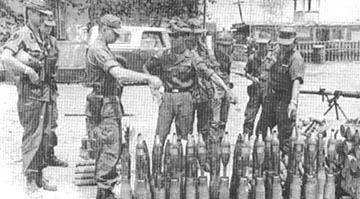 |
| CAPTURED - Colonel Louis J. Schelter Jr. of Columbus, Ga., second from left, Tropic Lightning 3d Brigade commander, checks over a recent enemy arms and ammo cache captured six miles southeast of Dau Tieng. Checking over the arms with him is Major Tran Kim Dinh, Khiem Hanh District Chief. The huge haul was found by RF-PF soldiers and mechanized infantrymen from Charlie company of the Triple Deuce, whose commander, Lieutenant Colonel Ralph Cline of Rockville, Md., looks on. (PHOTO BY CPT R. A. STEINHAUSEN JR.) |
Tunnel & Cache Found by Manchus
TAY NINH - The men of D Company, 4th Battalion, 9th Infantry
Manchus located an enemy weapons cache including an 82mm mortar tube and 45
Rocket Propelled Grenade rounds 12 miles south of Tay Ninh City.
The Manchus were sweeping an area from which they had been mortared
the previous night while securing Fire Support Base Stoneman.
Company Commander Captain Nathan H. Kniker's curiosity was
aroused when he spotted a patch of loose dirt covered by piles of discolored
vegetation. Kniker, of Bellville, Ill., investigated the patch and
discovered a tunnel four feet by six feet.
Private First Class William M. Peeples of Clayton, Ga., and
Sergeant Joe Ambrus of Fairfield, Conn., were immediately commissioned to
investigate the possible enemy stronghold.
They returned to the surface with an 82mm mortar tube, base plate,
aiming stakes, various maintenance tools, 45 RPG rounds and eight bangalore
torpedoes were dragged from their hiding place.
|
BULLETIN! DAU TIENG (9 May) - A 3d Brigade mechanized unit crashed through thick jungle this morning to surprise North Vietnamese troops entrenched in a large bunker complex and open an eight-hour battle in which 77 enemy died. The Tropic Lightning soldiers, operating with strong helicopter gunship and fighter-bomber support, incurred light casualties in the battle near here. |
Page 2 TROPIC LIGHTNING NEWS May 19, 1969
Decorated
| BRONZE STAR MEDAL (HEROISM) | |
| COL Homer S. Jr.,
HHC, 2d Bde COL Gordon Sumner, Jr., HHC LTC Forest E. Pierce, HHB, 7th Bn, 11th Arty LTC Duane R. Tague, HHC, 2d Bn, 34th Armor MAJ Wayne A. Downing, HHC 2d Bde MAJ Leonard L. Miller, HHC, 2d Bn, 22d Inf CPT William C. Allison, Co C, 2d Bn, 22d Inf CPT Eugene J. Johnston, Co B, 2d Bn, 22d Inf CPT Jack E. Lewis, HHC G3 CPT Max A. Ray, Co A, 1st Bn, 5th Inf CPT Charles S. Nichols, Co A, 65th Engr Bn CPT Douglas S. Mulligan, Co A, 2d Bn, 27th Inf CPT Ardre F. Blackmon, A Co, 3d Bn, 22d Inf CPT Gregory J. Hayward, B Co, 1st Bn, 5th Inf CPT Elcie Adams, A Co, 4th Bn, 9th Inf CPT Carl Sweatman, HHC, 3d Bn, 22d Inf 1LT Paul Greenwalt, A Co, 1st Bn, 5th Inf 1LT Martin Beach, A Co, 2d Bn, 12th Inf 1LT George Reese, B Co. 25th Avn Bn 1LT Joseph Rio, C Co, 4th Bn, 23d Inf 1LT Gregor P. Schlau, B Co, 2d Bn, 12th Inf 1LT Dorothle J. Gillespie, D Co, 2d Bn, 14th Inf 1LT William S. De Boer, B Co, 1st Bn, 5th Inf 1LT Darrell B. Ratliff, Co C, 1st Bn, 5th Inf 1LT John L. Duke, Co B, 2d Bn, 34th Armor 1LT William C. Monaghan, Co A, 1st Bn, 5th Inf 1LT Gary G. Martin, Co A, 1st Bn, 5th Inf 1LT Kenneth. M. Tolley, HHC, 2d Bn, 14th Inf 1LT Byce Mills, Co C, 2d Bn, 27th Inf 1LT Eddie G. Rigsby, Co A, 2d Bn, 14th Inf 1LT Harold L. Zendt, Co B, 2d Bn, 14th Inf 1LT Joseph M. Logan, Co A, 1st Bn, 27th Inf 1LT Clyde Oatts, C Btry, 2d Bn, 77th Fld Arty 2LT Robert Hopkins, HHC, 1st Bn, 5th Inf 2LT James W. Sylvester, Co A, 2d Bn, 14th Inf CW2 Harrison H. Atkins, D Trp, 3d Sqdn, 4th Cav WO1 Mark D. Mitchell, HHB, 25th Inf Div Arty CSM William P. McClanahan, HHC, 65th Engr Bn, CSM William Clevenger, HHB, 7th Bn, 11th Arty CSM John E. Wise, HHC, 4th Bn, 23d Inf SSM Arthur B. Chambers, HHB, 25th Div Arty SFC Robert L. Stover, Co B, 2d Bn, 14th Inf SFC Shelton F. Barrs, Co C, 4th Bn, 9th Inf SFC Richard E. Colwell, HHC, 2d Bn, 12th Inf |
SFC Alvia M. Cooper, HHT, 3d Sqdn, 4th Cav SFC Rank M. Davis, HHC, 2d Bn, 22d Inf PSG Lonnie Jackson, A Co, 1st Bn, 5th Inf SSG Joseph P. Kern, Co C, 4th Bn, 9th Inf SSG Bernard R. Gdowski, Co C, 1st Bn, 5th Inf SSG James R. Digney, Co A, 2d Bn, 14th Inf SSG Jerry L. Helm, Co A, 2d Bn, 14th Inf SSG Lawrence Bracey, B Co, 2d Bn, 12th Inf SSG Michael Ferriter, Co E, 2d Bn, 27th Inf SSG Robert T. Chiesa, Co A, 1st Bn, 5th Inf SSG Roosevelt Wallace, Co A, 1st Bn, 5th Inf SSG Robert S. Correia, A Trp, 3d Sqdn, 4th Cav SGT William R. Dickinson, Co A, 2d Bn, 12th Inf. SGT Richard L. Hudson, Co C, 4th Bn, 9th Inf SGT Angelox Anselmo, HHC, 2d Bn, 27th Inf SGT Donald R. Beckstrom, C Co, 4th Bn, 23d Inf SGT Richard C. Judnich, Co A, 1st Bn, 5th Inf SGT Kenneth D. Smith, Co C, 2d Bn, 22d Inf SGT Clyde D. Lahr, Co C, 4th Bn, 9th Inf SGT Benard L. Spady, C Btry, 1st Bn, 8th Fld Arty SGT Thomas J. Robbins Jr., A Co, 1st Bn, 5th Inf SP5 Willie G. McKinney, C Co, 3d Bn, 22d Inf SP5 Steve E. Teems, Co F, 50th Inf SP5 Dwight W. Birdwell, C Trp, 3d Sqdn, 4th Cav SP4 Richard O. Myers, C Btry, 1st Bn, 8th Fld Arty SP4 Orvall Day, C Btry, 1st Bn, 8th Fld Arty SP4 Edward L. Nixon, Co C, 4th Bn, 9th Inf SP4 David L. Powell, Co A, 2d Bn, 14th Inf SP4 Nathaniael M. Johnson, C Btry, 1st Bn, 8th Fld Arty SP4 Roger D. Glover, C Btry, 1st Bn, 8th Fld Arty SP4 Thomas E. Beecherl, HHC, 2d Bn, 34th Armor SP4 Dale S. Beel, Co A, 2d Bn, 14th Inf SP4 Raymond Larson, Co A, 1st Bn, 27th Inf SP4 Timmie Johnson Jr., C Btry, 1st Bn, 8th Fld Arty SP4 Stanley G. Pylar, Co E, 2d Bn, 27th. Inf SP4 Renard Godwin, Co C, 1st Bn, 5th Inf SP4 Jerry L. Rudlaff, Co C, 1st Bn, 5th Inf SP4 Ralph T. Lemme, D Co, 2d Bn, 14th Inf SP4 Ronald P. McTaggart, A Trp, 3d Sqdn, 4th Cav SP4 Willie J. Maull, A Co, 2d Bn, 34th Armor SP4 James L. Thompson, C Trp, 3d Sqdn, 4th Cav SP4 Gary Conner, D Co, 2d Bn, 27th Inf PFC Melvin Bimberg, D Co, 3d Bn, 22d Inf PFC Barry L. Aumiller, A Co, 2d Bn, 27th Inf |
Annual Freedom Letter Contest Open for Entries
Rules and the topic for the annual Freedoms Foundation Letter
Awards Program have been released for this year's contest.
The subject is 'My hopes for America's Future! All
members of the Armed Forces, both in Active and Reserve status, as well as
senior ROTC Cadets, are eligible.
Letters must not exceed 500 words.
Print or type your full name, rank, service number, full military
address, service or reserve component and full home address. Notification
of winners will be made in February, 1970.
Your entries should be sent to Freedoms Foundation, Valley Forge,
Pennsylvania 19481, postmarked by November 1st.
Top award is $1,000 for the best letter from an active duty member.
In addition, there are 50 awards of $100 each and another 50 awards of $50 each.
Freedom Foundation is an independent non-profit organization not
affiliated with any sectarian religious group or political party. It is
dedicated to building an understanding of the constitution and the bill of
rights, to inspiring love of freedom and to supporting the spiritual unity born
of the belief that man is a dignified human being.
Winners in the letter competition are selected by an independent
jury.
Winning letters are spotlighted, distributed and published to
provide more and heavier ammunition in the struggle of free men for their
personal liberty and dignity against every totalitarian, compulsive, tyrannical
force.
Honor War Goals, Gen. Abrams Says
On Memorial Day, 1969, let all Americans in Vietnam pause to
consider the significance of our efforts to assist the brave and dedicated
people of the Republic of Vietnam. Our mission is to defeat the enemy,
protect the people, and help them build a free and independent nation.
Each of us, whatever his job, on land, sea or in the air, stands ready to meet
any challenge to insure the success of our commitment here.
I take great pride in acknowledging your heroic actions on the
battlefield and your deeds of goodwill in the countryside. Your courage and
devotion are an example to the people of the world of our nation's
determination to defend the institutions of freedom.
Your achievements mark you as the finest "forces for freedom"
our nation has ever had. You deserve the honor, the respect and the
support of all the American people ... for you are America's best.
CREIGHTON W. ABRAMS
General, United States Army
Commanding
Fake MPC Found In Circulation
Counterfeit Ten Dollar Military Payment Certificates (MPC) are
being circulated, according to the Comptroller's Office, Military Assistance
Command, Vietnam.
The counterfeits are described as being "of fair quality," and
were discovered when two of them were used to purchase a postal money order.
The coloring of some parts of the imitation notes is different from
that of genuine bills. In addition, the counterfeits are printed on a
lighter weight paper.
An investigation is underway. Meanwhile, facilities
authorized to deal in WPC have been alerted to watch for counterfeits.
Free Mail Doesn't Cover Newspapers
U.S. Army postal officials have reaffirmed that unit newspapers and
magazines cannot be sent home as free mail.
Military Assistance Command directives (MACV Dir 65-2) explain that
free mailing service is limited to personal letter mail, post cards in the usual
and generally accepted form, and sound recorded communications. Tape
recordings must have the character of personal correspondence.
Inclosures such as pictures or clippings which are incidental to
personal letters may be inclosed. Complete issues of magazines or
newspapers cannot be considered as clippings, however.
Printed matter - such as newspapers or magazines - can be sent at
the regular first class rate, or at a lower rate if sent clearly labeled
"printed matter."
Tropic Lightning Tots
The Commanding General Welcomes
The Following Tropic Lightning Tots
To The 25th Infantry Division – As
Reported By The American Red Cross.
Born To:
| April 16 SFC Gordon J. McClellan, Co A 125th Sig Bn, a son April 19 SP5 James A. Dial, HHC 25th Div, a daughter April 28 SSG Cleveland R. Merrow, Jr. HHC 2d Bde, a son SP5 John L. Brown, 25th Admin, a daughter SP4 Kenneth E. Robinson, Co E 725th Maint Bn, a daughter April 29 MAJ Charles W. Addicott, Co A 25th Avn Bn, a daughter SP5 Dwight D. Darnell, A Trp 3/4 Cav, a son |
April 29 SP4 Armando J. Lopez, 25th Admin Co, a daughter May 2 SP4 Eugene R. Welke, Co A 725th Maint, a daughter May 3 PVT Dennis A. Mills, Co E 2/27 Inf APO 96225, a son May 4 SGT Kenneth M. Miyakawa, Co E 65th Engr Bn, a daughter SP4 Dwight H. Wormer, Co C 65th Engr Bn, a son May 5 1LT Robert R. Farrar, 25TH MP Co, a daughter |
The TROPIC LIGHTNING NEWS is an authorized publication of the 25th Infantry Division. It is published weekly for all division units in the Republic of Vietnam by the Information Office, 25th Infantry Division, APO San Francisco 96225. Army News Features, Army Photo Features, Armed Forces Press Service and Armed Forces News Bureau material are used. Views and opinions expressed are not necessarily those of the Department of the Army. Printed in Tokyo, Japan, by Pacific Stars and Stripes.
MG Ellis W. Williamson . . . . Commanding General
MAJ John C. Fairbank . . . . . Information Officer
1LT John C. Burns . . . . . . . . Officer-in-Charge
SP4 Robert Imler . . . . . . . . . . Editor
SP5 Charles Withrow . . . . . . Assistant Editor
SP4 Jim Brayer . . . . . . . . . . . . Production Supervisor
Page 3 TROPIC LIGHTNING NEWS May 19, 1969
Wolfhounds Secure Area Surrounding Diamond III
PATROL BASE DIAMOND III - After Wolfhound soldiers from the 2d
Battalion, 27th Infantry had successfully routed an enemy assault on Patrol Base
Diamond III they faced a big problem. What could be done with the large
number of enemy fighting positions surrounding the tiny patrol base to prevent
Charles from trying another attack?
One thing was certain. The anti-aircraft emplacements had to be
destroyed.
The dilemma was solved by the use of two agents. One was C-4
explosive in the form of 40pound shaped charges, and the other was CS riot
control powder.
The enemy positions, 12 in all, were circular trenches with columns
of earth left in the center. The pedestals of dirt served as support for the big
.51 caliber anti-aircraft machineguns used from the locations.
The mounds were leveled by the huge 40-pound charges, and then the
craters were made unusable by spreading CS powder on the floor of the enemy
emplacements.
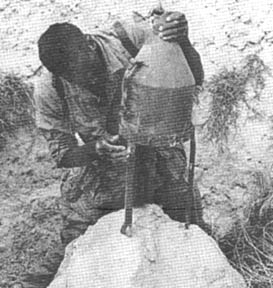 |
A 40-POUND SHAPED CHARGE will destroy the dirt mound used to support the heavy .51 caliber anti-aircraft guns. Specialist 4 Glen Davis of Kansas City, Mo., 65th Engineers, assigned to Company 3, 2d Battalion, 27th Infantry, skillfully prepares the explosive detonation. (PHOTO BY SP4 R.B. WILLIAMS) |
| HOLDING THE BAG - A masked trooper from A Company, 2d Battalion, 27th Infantry, empties an eight pound bag of riot powder into the blown anti-aircraft positions. (PHOTO BY SP4 R. B. WILLIAMS) | 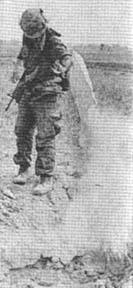 |
Wolfhounds Ambush 12
DAU TIENG - Wolfhound infantrymen of Alpha Company, 1st Battalion,
27th Infantry, killed three enemy soldiers in an ambush in the Trapezoid, 45
miles northwest of Saigon.
An estimated 10 to 12 enemy soldiers were observed moving east in
an open area. "They acted as if they wanted to avoid contact," said
Specialist 4 George Whitehead of Rockfort, Tenn.
The Alpha Company patrol engaged the enemy with small arms fire.
They received RPG fire in return, but suffered no casualties, said Sergeant Bill
Smith, the patrol leader.
Closed for Alterations
TAY NINH - While scaling the cliffs of Nui Ba Den the Regulars of
the 3d Battalion, 22d Infantry, captured a Viet Cong sewing machine along with
14 82mm mortar rounds and assorted small arms ammunition. The sewing
machine was used by the Viet Cong to make and repair uniforms.
Staff Sergeant William Jefferson of Charlie Company was the first
to enter the cave built into the side of the mountain.
"The cave entrance was huge," said Jefferson. "It was
about 30 feet high and led to several bamboo ladders leading to three different
levels. We moved slowly and carefully down the corridor of the first floor
and found a tailor shop that had been used a very short time before our
entry."
The VC base camp was large enough to accommodate a battalion-sized
unit. Several items of web gear and eating utensils were also found.
"I'll bet that tailor is really going to be upset." said
Sergeant Nelson Matos of Bethlehem, Pa. "It'll probably be several
months before he gets it replaced. Now we'll probably start meeting VC
with holes in their pants."
|
VROOM The may 2 issue of TIME magazine carried a story on the motorcyclists cruising the trails of War Zone C. With all of the publicity it's receiving, the Regulars' Recon Patrol seems headed for its own TV series. Just remember, you read it first, as always, in the TLN. |
Bronze Star to Viet Interpreter
TAY NINH - A Vietnamese interpreter ignored his own wounds to
help organize a defense and treat injured when a two-truck convey carrying
American and Vietnamese troops was ambushed.
He was decorated with a Bronze Star for valor by 25th Infantry
Division commander Major General Ellis W. Williamson at Go Dau Ha, March 18.
Nguyen Chon Duong, a local government interpreter, was riding in
the first of two three-quarter ton trucks carrying Vietnamese troops and part of
the Reconnaissance patrol of the U.S. 4th Battalion, 9th Infantry, about two
miles southwest of Go Dau Ha when his vehicle hit a command-detonated mine.
All the passengers in the first truck were thrown out by the blast,
but Duong, even though he had incurred shrapnel wounds, moved to help Sergeant
First Class Robert W. Leathers of Columbus, Ga., deploy a defensive force to
combat sniper fire that began to hit around the trucks.
Leathers recalled that Duong "ran through the automatic weapons
fire to place himself in position to assist in giving orders to the ARVNs
attached to our platoon."
"After we had everyone in position, Doung refused medical aid for
his own wounds, and went back to help both the GIs and ARVNs who'd been
wounded, helping our medic to treat them," Leathers said.
The American medic, Specialist 4 Tim C. Portal of Chicago also
praised Duong.
"Even though he'd been thrown out of the truck like the others,
and had been wounded, he came over to give me a hand," Portal said. "He did a lot in helping find out which ones were hurt the most, and he just
wouldn't let us get him out on a medical evacuation ship."
25th Unites Father, Son
CU CHI - Together again. And in Cu Chi of all places.
Specialist 4 Roy Jenkins, who has been in the Army for 24 years, returned to a
combat zone in order to be with his son, Private First Class Gary Jenkins.
Specialist Jenkins, age 50 (affectionately known as "Pop" to
the men of the 25th Division Bn.), volunteered for Vietnam duty when his son
enlisted in the Army on June 3, 1968.
Young Jenkins, who took his basic training at Ft. Polk, La., and
AIT at Ft. Bliss, Tex., volunteered for Vietnam service also. At Ft.
Benning, Ga., he received airborne training and then went on to Pathfinder
School.
Specialist Jenkins arrived in country on February 16, 1969, and
informed the Red Cross that his son was soon to follow. After being
assigned to Tropic Lightning's Band, he waited for his son's arrival.
On April 20, Gary reported to the 25th Replacement company, and father and son
were together again.
Wires Sing Across Frontier
TAY NINH - "Hang on to your white sombrero, Nellie, they're
pushing back the western frontier!" At least that's the way it seems
at old Tay Ninh City as the Lancers of the First Brigade do their bit to help
bring civilization to the hamlets around Cao Xa.
Latest idea in the continuing pacification campaign is stringing
communication wire from the Lancers' base camp at Tay Ninh across the plains
to the Phuoc Ninh district headquarters.
Like the "singing wires" carrying messages across America's
western frontier, the commo wire represents a significant step forward for
civilians and military people in Vietnam. And just as in the west, these
wires were strung by armed crews across hostile territory.
But you can tell this is the Vietnamese "west." Bamboo
poles hacked out of groves in nearby Binh Phon hamlet by the 1st Brigade's S-5
Section are used as telegraph poles.
"The idea came up in a meeting between brigade representatives
and district advisors," said Major Clarence DeYoung of San Diego, Calif.,
Lancer S-5.
Lieutenant Colonel Paul Applin of Deridder, La., executive officer
of the 1st Brigade directed the S-5 and brigade signal section to accomplish the
mission. Captain Howard McGill of Worcester, Mass., the signal officer,
planned the route and compiled a list of materials.
"Then we scouted the area for suitable poles. Buying them
from the people helps the local economy as well as provides durable building
material," said Major Clarence DeYoung.
The wire crew, under the direction of First Lieutenant William West
of Syracuse, N.Y., dug holes and strung wire on the bamboo poles.
"Naturally, we kept our eyes peeled for Viet Cong," said
Lieutenant West, "but nobody tried to stop us." Lieutenant Colonel
Applin placed the first official call to. Major Richard A. Petty, the District
Advisor at Phuoc Ninh District.
The new communications line links the westernmost village in the
III Corps Tactical zone with the communications networks emanating from Tay Ninh.
Bringing peace and security to western South Vietnam is every bit
as rugged a task as it was in the western United States over a hundred years
ago. The S-5 admits the value of a commo link and hints that the
"singing wires" will be followed by other effects. Now, about Project
"Iron Horse..."
Page 4-5 TROPIC LIGHTNING NEWS May 19, 1969
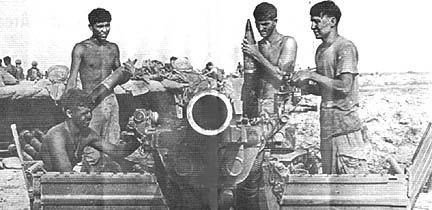 |
| HEAD ON - At Diamond III this 105mm was lowered and belched fire 159 times that long night. The crew, from left, consists of Specialist 4 Wayne Day of Anadarko, Okla.; Private First Class Mario Alvarando of Sunland, N.M.; Sergeant George Belich of Pittsburgh; and Specialist 4 Roger Glover from Mansfield, La. (PHOTO BY SP4 R. B. WILLIAMS) |
Artillery - The King of Battle -
1/8 Puts It Where It's Needed
By SP4 Bert Allen
FSB PERSHING - "Battery adjust!" These words command the
respect of the men of 1st Battalion, 8th Artillery. At this command,
cannoneers rush to their positions around the big guns, and begin to perform
their varied tasks to get the projectiles out where needed, when requested.
Located at three fire support bases and patrol bases Diamond II and
III, the cannoneers are constantly prepared to give their support.
The artillerymen have a never-ending task that results in little
visible reward. But the infantrymen and brown-water sailors on the Saigon
River have seen the effects of the battalion's precise firing. These
elements have been rewarded and the cannoneer is satisfied knowing that he has
assisted in defeating the enemy, or destroying his resources.
Bravo Battery of the 1/8 is not only a fighting battery. It
is a show unit capable of demonstrating the abilities of the artillery to any
and all visitors, from admirals and generals to Billy Graham or the stars of
"Peyton Place." Its guest list is impressive.
Also impressive are the awards for valor presented to the
battalion's cannoneers who stand by their guns during hostile fire.
First Lieutenant Stuart Green of Hartford, Conn., Bravo Battery
Executive Officer, is able to say, "We're number one in Vietnam, and we're
going to stay that way."
There is a strict discipline in the battalion in order to instill
in the cannoneers the ability to put out supporting fires rapidly and
accurately. The illusion of disorganization and uncleanliness at a fire support
base in the fields of Vietnam is soon dispelled upon arrival at any of 1st
Battalion, 8th Artillery, locations.
Each howitzer's parapet is constantly raked, and cleaned at least
twice daily. It is almost impossible to find a cigarette butt in the
battery areas.
The day of the artillerymen is long and arduous. If he's
lucky, he gets a few hours sleep at night, and that may be broken by fire
missions.
His early morning hours are spent maintaining and cleaning his
weapon, as well as the "office" - the gun's parapet.
Sometime during the day a convoy arrives bringing a strenuous task
for the gun bunnies - breaking out several hundred rounds of ammunition which
weigh approximately 35 pounds each.
During the distribution of ammo, other cannoneers may possibly be
firing more rounds, which makes the task seem eternal.
The never-resting "brain" of the artillery, the Fire Direction
Center, demands quick reactions and smooth, calm thinking from its men under the
most arduous conditions. It is not unusual to see the men of F.D.C.
finishing a fire mission as exhausted as the cannoneers.
It is in F.D.C. that data is gathered from the forward observers,
the "eyes" of the artillery with infantry units. The information is
then calculated and given to the cannoneers in terms suitable for the guns'
use.
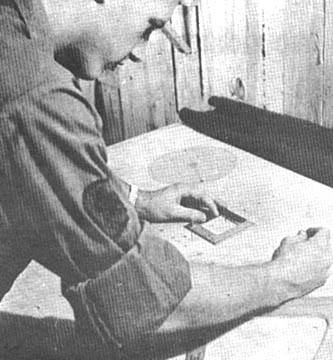 |
PLOTTING - Specialist 4 Charles Cline of Harrisville, W. Va., must plot the requested direction and distance of fire before firing data may be calculated and passed to the guns. (1LT R.S. PERRY) |
| SIGHTING IN - Specialist 4 Mario Santanna of South Pekin, Ill., performs the delicate task of setting the proper deflection before a round is permitted to leave the tube. His duty is similar to pointing a rifle in the right direction, but his work is much more complex. (PHOTO BY 1LT R.S. PERRY) | 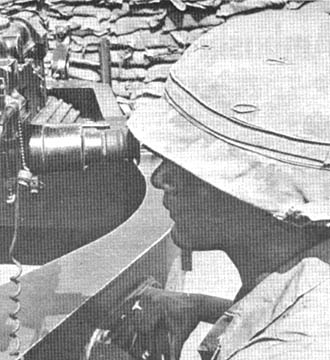 |
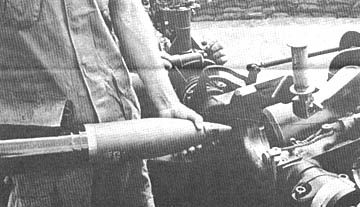 |
RAMMING THE PROJO - As the gunner sets the deflection and levels the bubbles on the sight, the #1 cannoneer rams the projectile and canister into the tube. (PHOTO BY 1LT R.S. PERRY) |
| PUNCHING THE TUBE - Two cannoneers from the First of the Eighth's B Battery prepare to clean the bore of their howitzer. Performing this daily task are Specialist 4 Kenneth Sedburry of Hillcrest Heights, Ohio, and Private First Class Frederick DeBolt of Ottawa, Ill. (PHOTO BY 1LT R.S. PERRY) | 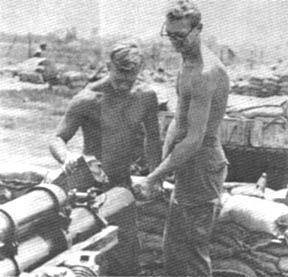 |
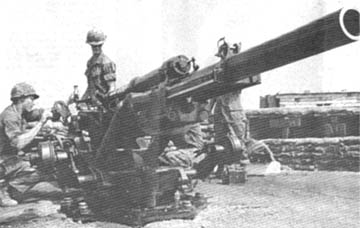 |
READY AND SET - Corporal Dale Dahlinger of Toms River, N.M., and Specialist 4 Doyle Reynolds of Bisbee, Ariz., assist in preparing the gun to fire. Dahlinger is setting the elevation of the tube while Reynolds rams the projectile into the breech. (PHOTO BY 1LT R.S. PERRY) |
| RECEIVING THE COMMANDS - Sergeant Charles Garrison of Rome, Ga., gets the gun's commands from F.D.C. and passes them on to the cannoneers. Crew members are from left Corporal Dale Dahlinger of Toms River, N.J.; Specialist 4 Doyle Reynolds of Bisbee, Ariz.; and Sergeant Billy Browning of Little Rock, Ark. (PHOTO BY 1LT R.S. PERRY) | 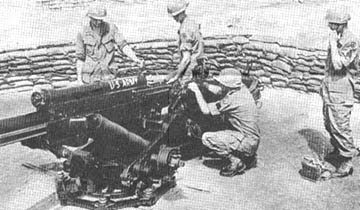 |
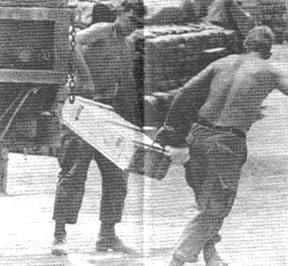 |
TOTE THAT BOX - Two cannoneers from Bravo Battery unload two of the several hundred rounds going to FSB Pershing daily. (PHOTO BY 1LT R.S. PERRY) |
Page 6 TROPIC LIGHTNING NEWS May 19, 1969
Ambush: A Vital Tool for Jungle Warfare
DAU TIENG - Ambush! Typically an unconventional tactic, used by
unconventional forces. But Wolfhound infantrymen of 1st Battalion, 27th
Infantry, are taking the "un" out of unconventional and are employing the
art of the ambush successfully against the enemy - an enemy that doesn't know
how to fight any other way.
Emphasis was placed on the battalion's ambush operations when
Major Jerry Holliday of Memphis, Tenn., took over as the Wolfhound's
operations officer early this year.
"We needed to change our tactics," Holliday said. "We wanted
the enemy to come to us instead of always going into the field on
reconnaissance-in-force operations, looking for him. My idea was the
ambush - quite irregular for a TO & E unit - but I thought it would work
when proper emphasis was placed on it. The idea was unanimously supported
by other battalion leaders," he said.
The proper emphasis was placed on ambush techniques, first through
seminars attended by battalion leaders - and then by means of an "ambush
school" held at Fire Support Base Mahone II.
"At our seminars, we'd all get together and take a good look at
ourselves," Holliday said. "We'd find out what we were doing right -
and wrong - in our operations against the enemy."
The school at Mahone II was run "Country Fair" style, with the
Wolfhounds rotating from station to station, learning and relearning the arts of
the ambush.
"One thing we found out right away was that the men weren't
hitting what they were seeing," said Major Dallas L. Cox of Pulaski, Va., the
battalion executive officer and also one of the officers responsible for the
training school.
"The school set up both a zeroing and quick reaction course
designed to train our men to pause long enough to take aim on the enemy," he
said.
Other stations at the school included a machinegun course, weapons
demonstrations, first aid, ambush techniques and an introduction to scout dogs.
"The weapons demonstration gave the men an idea of the awesome
firepower a small unit possesses while on an operation," Cox said. "This gives the men confidence and an aggressive spirit when they contact the
enemy."
But how did the men respond to "training" after many of them
were already seasoned in combat?
"At first, they didn't like the idea, but after an excellent
class given by the scout dog platoon sergeant, the ice was broken, and most of
them really enjoyed themselves," Cox said. "Our soldiers today are
intelligent, and many realized they were deficient in some aspects of weaponry
and wanted to learn - they knew it could save their lives," he said.
In addition to this "ambush school," which both Holliday and
Cox hope to run once every month, the battalion has initiated training between
operations for the Wolfhounds.
"We have the men zero their weapons at every opportunity during
these training sessions," Holliday said. "Besides weapons training, we
give the men intelligence briefings, first aid classes and other combat tips,"
he said.
But, the big question. Have the seminars and training paid off
where it counts - in the field?
"They certainly have," said Holliday. "We've tried
our ambush techniques in three different areas of operation and in three
different types of terrain - the "triple canopy" jungle of the Trapezoid,
the flat, open areas of a rubber plantation and the swampy regions of the Boi
Loi Woods - and we've had success in all these areas.
"Some of our companies have experimented with night movement in
an attempt to become even more of a threat to the enemy. We've had great
success with this too. As a matter of fact, several times during these
night movements, Viet Cong soldiers have walked right up on a company, thinking
it was an element of the North Vietnamese Army."
"The enemy just couldn't believe a whole company of American,
troopers would move at night," he said.
The Wolfhounds are motivated, there's no doubt, and they're
making the enemy take careful stock of himself before he tries any mass
movements within their area of operation, Holliday concluded. "We're
very proud of our ambush record."
Ready Cav Throws Back NVA Attack on Night Laager Position
CU CHI - A Troop of the 3d Squadron, 4th Cavalry, turned back an
attack by an enemy battalion six miles west of Dau Tieng.
All vehicles formed a large circular perimeter for the troop's
night laager.
The attack launched just after midnight, took no one by surprise.
The Cavalrymen were warned in plenty of time by their night listening teams
which were positioned around the perimeter.
The area immediately around the laager site was fairly open with
just a few scattered hedgerows. The main supply route to Dau Tieng was
approximately 500 yards away.
There was little cover for the listening teams. Five hundred
yards to the north of the Cav's laager the tropical growth became more dense.
For this reason the Troop's Commanding officer, Captain John T.
Wells of Cumberland, Ky., gave specific orders to his troops to keep a close
watch on this area.
Each of the listening teams was in position by 8:30 p.m.
After a two-and-a-half hour wait, movement was sighted by the 3d platoon LP.
The movement was reported over the radio, and all teams were completely aware of
the situation.
Before the advancing enemy soldiers got too close to the third
platoon's LP, Wells gave the order to pull the team back to the safety of the
perimeter. The team reported the enemy moving in columns toward their
position, fanning out around the perimeter of the vehicles.
Soon the enemy troops could be seen clearly by the cavalrymen who
waited behind their guns. The Horsemen Watched in readiness as the North
Vietnamese soldiers came closer and closer.
Two of the LPs at this time were back in the laager site, leaving
only one squad from the 1st platoon still in position on the west side of the
perimeter.
Then the order to "stay low" came over the radio to the first
platoon's LP, as the main gun of a Sheridan blasted away on a small group of
NVA soldiers. Small arms and automatic weapons fire smashed into the NVA.
Wells explained, "We threw the first stone and it really hurt
them. They didn't even have time to set up their machineguns or
recoilless rifles."
After parachute flares lit the surrounding rice paddies, every
enemy position was spotted and knocked out. Specialist 4 Allen W. Slocum
of Anaheim, Cal., said, "As our flares were popping over the enemy we could
see them out there running around in confusion like a bunch of rabbits.
Then some of the NVA soldiers began dropping their weapons and scattered."
It wasn't long before indirect fire came whizzing over the heads
of the first platoon's LP. Specialist 4 David Olsen of Alhambra, Calif.,
said, "We were receiving enemy fire from the far side of the perimeter.
On top of that we had to radio in and request permission to pull into the
laager. The NVA soldiers were crawling all around us. We no sooner
got up to run back in when the enemy was almost crawling up our backs."
The team entered the circle of tracked vehicles and then permission
to fire to the west side of the perimeter was given.
It wasn't long before the supporting artillery from Fire Support
Base Wood, located in Dau Tieng, came smashing into the area. Huey Cobras
from Delta Troop swooped down as the remaining enemy soldiers scrambled for
cover.
The battle went on through the night and ended in the early morning
hours. At dawn, 17 dead NVA soldiers lay in front of A Troop's laager
site. A sweep of the area revealed a large number of weapons, ammunitions
and documents. A further search revealed 21 more dead NVA soldiers had
been hidden.
There was only one light casualty among the 3/4 Cav troopers
resulting from the enemy's fire.
Wire for the enemy's communications was left strung all over the
area. Antitank and rocket propelled grenades were scattered everywhere.
Gas masks, shovels, and picks were also captured along with several light
machineguns and AK-47 rifles. Mortar rounds were left in place along with
boosters and ammunition for different weapons. Fifty-eight Chicom hand
grenades and one sling shot were also captured.
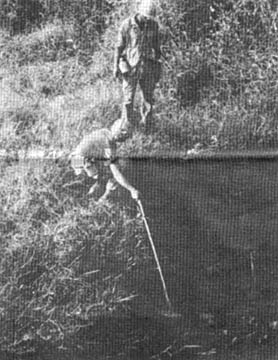 |
SEARCHING THE BANKS of the Soui Tri Bi River, 19 miles north of Tay Ninh City for enemy mines are engineers working with C Company, 4th Battalion (Mechanized), 23d Infantry. (PHOTO BY SGT ROGER WELT) |
Page 7 TROPIC LIGHTNING NEWS May 19, 1969
Tam Dap Forests Flattened By Rome Plow Engineers
By SP4 John Genitti
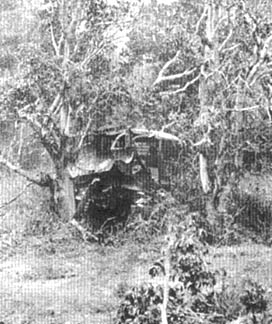 TAY NINH - Paul Bunyan himself couldn't do a better job.
TAY NINH - Paul Bunyan himself couldn't do a better job.
The men and equipment of the 501st Engineering Land Clearing
Company have it all over the legendary lumberjack, however. Instead of
using a big blue ox, the men of the 501st are using massive Rome plows to cut
down the triple canopy, Tam Hap jungle, just southwest of Tay Ninh base camp.
The land clearing project has a two-fold purpose: a
pacification program for the Vietnamese villagers, and the safeguarding of Tay
Ninh itself.
"We are literally cutting down Charlie's hiding places by
getting rid of this jungle," said the company commander, Captain John MacNeil, Providence, R.I.
"The men we have out here at this time are all doing a real fine
job," MacNeil added. With the 16 plows we have now, we can clear about
500 acres a day. We are continually cutting down on the 3,000 acres of
land we were assigned to clear on this project. On a good day we can clear
up to 600 acres, but that's really pushing it. These machines can take a
lot of punishment even though they need a rest and maintenance periodically."
Security for the engineering company is provided by the 4th
Battalion (mechanized), 23d Infantry Tomahawks.
The mechanized battalion according to MacNeil, is doing a fine job
looking out for the engineers.
A MEMBER of the Tomahawks, Private First Class Sidney Higa of
Honolulu, Hawaii, said that "the daytime security is set up in a satellite
type defense, because the plows cut out in a circular pattern and it's much
easier to set up a perimeter. At night, a regular bunker line is set up
and our company gets some support from the ARVN troops in the area."
A daily convoy to Tay Ninh is made to pick up food for men in the
field. They are also supplied with ice and sodas.
The name "Rome Plow" comes from the company which manufactures
the tree-cutting blade mounted on the front of the 32-ton Caterpillar tractor.
Once an area is cut down, it is not cleared for a week.
During that time villagers are given a free hand to take wood from the area
before it is burned.
(Above, right) NOTHING is too big or too tough to withstand the brute
force of a Rome Plow. The 33 tons of metal can flatten anything in its
way. (PHOTO BY SGT ROGER WELT)
Tomahawks Triumph In Mountainside Battle
TAY NINH - Playing a deadly game of hide and seek on the side of
Nui Ba Den Mountain, Tomahawks from the 4th Battalion (Mechanized), 23d
Infantry, killed eight Viet Cong.
The Tropic Lightning troops were inching their way up the mountain,
checking everywhere for evidence of Charlie when the firelight erupted.
Initial contact was made when an enemy soldier jumped out of a hole
15 feet in front of the pointman and tossed a Chicom grenade at him. The
pointman rolled underneath a rock, escaping the blast and certain death.
"As soon as the first grenade went off, two snipers opened up on
us. They were on top of two giant rocks," said Sergeant Henry Pistilli
of Levittown, Pa. "In back of the snipers we could see a mortar team
pumping out rounds, we immediately called in support from the tanks we had down
at the bottom of the mountain," continued Pistilli.
As the Tomahawks, tanks and one eight-inch self-propelled artillery
piece saturated the mountainside, the VC guns fell silent.
When the smoke lifted from the rocky mountainside, eight Viet Cong
lay dead as the result of American firepower.
Fire Support Bases: Quick Studies
TAY NINH - "Another opening, another show . . ." go the
lyrics of a Cole Porter popular song. The Army too has its way of
providing openings and shows. Recently the 65th Engineer Battalion
constructed and opened a new fire support base west of Tay Ninh City.
"The planning of a semi-permanent fire support base' takes
several days - depending, of course, on the terrain and coordination with the
movement of equipment and security," stated Captain Charles Nichols of Los
Angeles, Calif., in charge of all engineering aspects and construction of the
fire support base. With all the preliminary planning accomplished,
construction is usually completed in only one day.
The planning of a fire support base begins with the brigade's
selection of a site. The proposed site is coordinated with the
Engineers' analysis of terrain - features and the feasibility of construction
on that area. Reconnaissance information aids in that particular decision.
When the site is decided upon and coordinated, a joint effort
begins with the engineers, artillerymen, and infantry. The areas are
secured and swept of mine fields. A convoy of engineers and all their
equipment makes its way through the secured roadways to the future fire support
base area.
Once there, the actual construction begins. Amid dust flying,
the grinding sounds of operating machinery and men working everywhere, a fire
support base begins to materialize.
It's all simultaneous action. Dozers with Rome plow blades
are unloaded from their carriers and immediately begin to push aside the brush
and trees.
Dump trucks and dozers pile a berm of rock and soil on the camp's
circumference. Scores of men uncoil and string concertina wire barriers.
Scoops and dozers begin digging pits to house the occupants of the new fire
support base.
A communication tower is erected and put into operation. Men
fill sandbags and construct bunkers. The sun begins to dim; the job is
almost done. An artillery company moves in and sets up its equipment.
Finally the infantrymen move in.
Fire Support Base Washington Up, Ready for Action
TAY NINH - In a recent move, artillerymen from A Battery, 7th
Battalion, 11th Artillery, pulled out of a fire support base near Tay Ninh. and
went west, to build Fire Support Base Washington closer to the Cambodian border.
A Battery moved into their new position with Company D, 3d
Battalion, 22d Infantry. Upon their arrival, the area was being cleared by
bulldozers from Company A, 65th Engineers. The men had a tremendous task
ahead of them. A perimeter had to be built and secured along with bunkers
and parapets for the 105mm howitzers.
Tactically, the new, fire support base is in a position to block
two enemy supply routes from Cambodia, one a road, the other a river. The
river is located a mere 1,200 feet from the perimeter.
Captain H. D. Neal of San Antonio, Tex., the A Battery commander,
had this to say, "The move establishes a fire support base between the two
enemy supply routes, and in addition it is now possible for us to cover the
entire rocket belt with artillery fire. The move itself came off very
smoothly. In just two days we've made a solid fire support base here."
By the following morning the new fire support base had already
taken shape. The men had been up late into the night, since they
couldn't go to bed until their bunkers were completed. The men were
exhausted, but their home was almost finished.
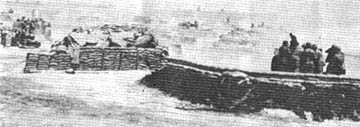 |
PREP MISSION - Prior to moving out of their original fire support base and convoying west to build a new one, the battery fires three and four round bursts during a prep mission to prepare the area and provide support for the engineers and infantry. (PHOTO BY SP4 PETE FREEMAN) |
| BUILD A BUNKER - After arriving at their new field position, artillerymen from A Battery, 7th Battalion, 11th Field Artillery begin the task of building themselves a bunker. Each gun section must also build an ammunition bunker and a parapet surrounding the 105mm howitzer. (PHOTO BY SP4 PETE FREEMAN) | 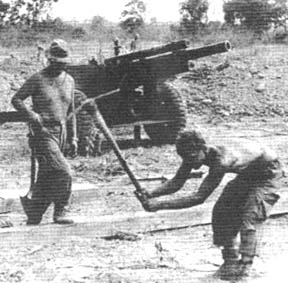 |
Page 8 TROPIC LIGHTNING NEWS May 19, 1969
D Troop
Cavalry Boasts Flexible Air, Ground Team
CU CHI - Quick and efficient support is the mission of D Troop, the
aerial arm of the 3d Squadron, 4th Cavalry.
D Troop's Commanding Officer, Major William Laird of Tampa, Fla.,
describes his unit this way, "We fly anytime and anyplace that Squadron
requests. Normally we have gun teams, flare ships, dustoff and
visual reconnaissance flights on stand-by, 24 hours a day. In addition, we
fly for other units in the division," Laird explains, "but supporting
Squadron is our primary function."
D Troop is sometimes thought of as a mini-aviation battalion.
It has OH-6As for visual reconnaissance and Command and Control flights; AH-1G
Cobras for gun support; and UH-1 slicks for carrying troops and supplies.
D Troop has one platoon not normally found in an aviation unit, the
Aero-Rifle platoon. This is a regular infantry platoon used to develop the
combat situation on the ground. An elite unit, the aero-rifles have
figured strongly in numerous actions involving the Squadron.
The pilots and aircraft commanders flying the Cobra gunships are
experienced and highly qualified. Experience is an absolute necessity when
fire support within 50 meters of friendly troops is needed.
This support is awe-inspiring to say the least. With
mini-guns, grenade launchers and rockets pounding away at Charlie, it is small
wonder that ground troop commanders often pay personal visits to the pilots to
say "thanks."
Captain William Cirincione, Cobra platoon leader, has nothing but
admiration for his men. "From the crew chiefs and armorers to the
pilots, I have never worked with such a dedicated and professional group of
men," praised Cirincione of Cleveland, Ohio.
The aero-scout platoon has the most exciting job in the Troop.
The aero-scouts fly at tree-top level in front of advancing ground troops to
look for the enemy in his lairs. If the LOH discovers Viet Cong, it can
engage the target, provided it is not too large. The pilot calls in the fire of
his covering Cobra.
Between the two aircraft, the enemy usually winds up with the short
end of the deal. This method used to discover the enemy has enabled the
ground commanders to change their plans to suit themselves, not the enemy.
The advancing LOH carries a crew chief and observer who both act as
door gunners. Their eyes have to be sharp and their reflexes fast.
Numerous North Vietnamese Army soldiers have found out just how quick they are,
but are not around to tell about it.
First Lieutenant Gerald Odom of Mount Dora, Fla., is the platoon
leader. He compares the Indian scout of yesterday to the modern LOH.
"When the enemy has to he found, the scout will do it," says Odom. "Years ago it was a man on a horse, today it's men in an aircraft."
The work horses of the Troop are the slicks. They slingload
ice to thirsty troopers, carry their mail and resupplies, provide medical
evacuation no matter how hot the action is, give illumination with flares,
transport the aero-rifle platoon on assaults, insert and extract Rangers, and
perform many other missions.
Captain William Reavis of Greensboro, N.C., has command of all
facets of slick and aero-rifle operations. "We have pulled as many as five combat assaults in one day and then flown all night when the
Squadron made contact," relates Reavis.
My pilots and crew members are nothing less than outstanding,"
said Reavis. "They exhibit great courage on every mission we have.
Not only that, but they sometimes work through the night just to make sure the
aircraft are ready to go the next day."
The aero-rifle infantry platoon is a highly mobile force capable of
swift reaction to any situation. From scramble horn to insertion is
usually only 20 minutes.
First Lieutenant Eugene Carolan, of Detroit, Mich., is the ground
platoon leader. His situation is unusual for an aviator. He has
earned the Combat Infantry Badge for ground action in addition to his flying
duties. He enjoys leading the "Rifles" and considers himself fortunate
from the standpoint of experience.
The heart of D Troop is the operations center. Captain
William Chiaramonte of Albuquerque, N.M., receives missions from the 3/4 Horse
S-3 and passes them down to the appropriate platoon leader. Since the
Centaurs could be on many different missions simultaneously, it is necessary
that Operations be a well-run and efficient machine.
"We have to know everything to make the Troop function
efficiently," Chiaramonte explains. "To insure efficiency I have radio
operators, operations sergeants, clerks, and an artillery liaison officer.
They're kept pretty busy throughout the day and night. We never
close!"
A vital part of the Troop efficiency is the Service Platoon.
First Lieutenant Jack Dickson of Tullahoma, Tenn., has direct command of both
the maintenance section and supply section. The job which occupies the
majority of his time is maintenance of the Troop's helicopters.
Dickson's crews work around the clock, side by side with the crew
chiefs from the flight sections. In addition, the avionics and armament
sections make sure the aircrafts have good communications and that weapons are
functioning properly.
The supply section cares not only for the mundane replacement of
pencils and other gear, but also services the fuel tankers and wheeled vehicles
in the unit.
Delta Troop is large. It must be to insure combat
effectiveness. It is a proud troop, part of a proud squadron. From
the pilots to the supply clerk, professionalism is a way of life.
The ground troops know that when the Centaurs are requested, the
job will be well done and done fast.
Captain Garrett Marcinkowski of Cohasset, Mass., the Executive
Officer of D Troop, sums it up this way, "You name it, we've done it.
If we haven't, nobody has."
| GRIN - Shark's teeth on Cobras are synonymous with the ferociousness of D Troop, 3/4 Horse of the Tropic Lightning Division. the enemy has learned to respect the awesome firepower of the Cobra and the accuracy of the Centaur pilots. (PHOTO BY SP4 JOHN T. AGNOLETTI) | 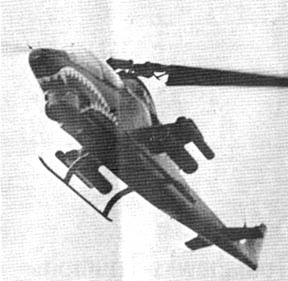 |
Tropic Lightning Exchanges Generals
In a recent ceremony at the headquarters of the Tropic Lightning
Division, Brigadier General Carlton Preer, Jr., said his farewell to the
division and was awarded a Distinguished Service Certificate for his outstanding
work.
General Preer served as assistant division commander for support
for six months and then became the assistant commander for maneuver, a post he
held during the rest of his tour.
Working out of 1st Brigade headquarters in Tay Ninh, General Preer
had the responsibility for planning and executing combined operations of
American forces in the Tropic Lightning area of operations. In tribute to
General Preer's outstanding success, ARVN airborne soldiers awarded him
Vietnamese Jump Wings in a Tay Ninh base camp ceremony.
General Preer moves now to become adviser to Vietnamese Armed
Forces in III Corps at Bien Hoa. Brigadier General Edwin Black will assume
duties of assistant commander for maneuver.
New to the Tropic Lightning division is Brigadier General David S.
Henderson, assistant division commander for support, whose last post was at the
army command and general staff school at Ft Leavenworth.
General Henderson entered the army in 1942 from the ROTC unit of
Mississippi State. He earned a master's degree in business administation
from Harvard in 1949.
No stranger to Viet Nam, general Henderson was an adviser to an
ARVN regiment in 1956. After his first Viet Nam tour, he was sent to the combined
arms command of the general staff college where he was acting chief of the
department for a year.
From the staff college, the general eclectically attended the Naval
War College at Newport, Rhode Island.
After a tour as chief of staff of the 3d Infantry Division, he was
transferred to Washington for a three year tour. And from Washington he
once again returned to the staff college, serving as assistant commandant and
later as deputy commandant.
| AU REVOIR - Brigadier General Carlton Preer, Jr., addresses the Tropic Lightning Division for the last time as assistant commander for maneuver. Major General Ellis W. Williamson, CG, and Brigadier General Edwin Black, new assistant commander for maneuver, share the platform. (PHOTO BY SP4 HARRY ANDERSON) | 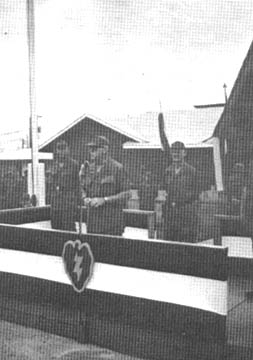 |
2/34 Aids Support Base
Thanks to
Mack D. Gooding, 15th PID, 1st Bde., for sharing this issue,
Kirk Ramsey, 2nd Bn., 14th Inf. for creating this page.
This page last modified 8-12-2004
©2004 25th Infantry Division Association. All rights reserved.